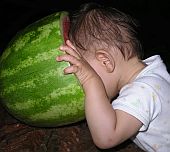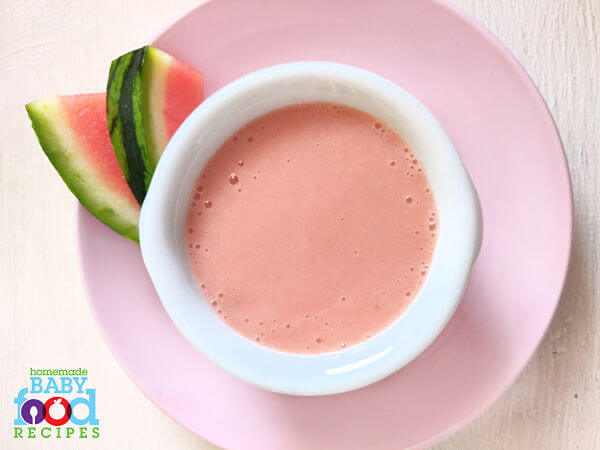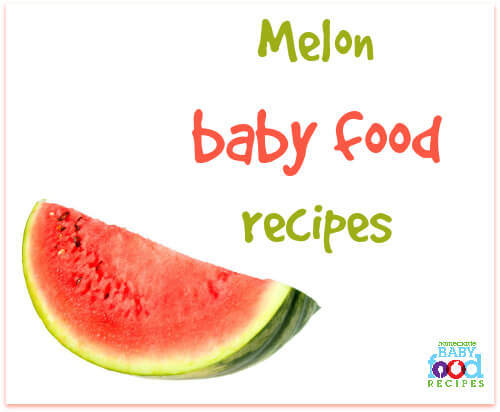Melon Baby Food Recipes and Ideas
Updated: July 06, 2023
These melon baby food recipes help you create luscious dishes for your baby using this nutritious and versatile fruit.
PLEASE NOTE: You should always discuss the introduction of ANY new foods with your child’s doctor.
When can babies eat melon?
There are no hard and fast rules when it comes to introducing melon to your baby and many infants enjoy it from 6 months of age with no problems at all.
There are, however, a couple of things to consider if you want to give melon to your little one…
- Although uncommon, melons can cause allergic reactions (usually tingling or itching around the mouth) in some babies.
Babies most at risk from this type of reaction are those with asthma.
Melon allergy is also associated with sensitivity to pollen, so it is often found in people with hay fever. - You may wish to delay the introduction of melon to your baby until later in his first year, particularly if he or anyone in the family suffers from the conditions above.
- Because they grow at ground level, melons are more commonly found to be contaminated by bacteria than tree fruits.
You should always wash the skin thoroughly before cutting it for your baby.
This prevents bacteria being transferred, via the knife, to the flesh of the fruit.
Handy tip
Slice melons under water – this is believed to minimize cell damage, keeping the melon fresh for longer!
We would recommend only buying whole melons for your baby and cutting them yourself.
You should try to avoid pre-packed, sliced melon – but if you DO buy it, then wash the slices before use… even if the labelling tells you it’s unnecessary.
Melon baby food – the benefits for your little one
Not only are melons juicy and delicious… they’re packed with goodness, too!
What’s more, most babies love them – so these melon baby food ideas are a great way to include some important nutrients in YOUR baby’s diet!
There are two types of melon – muskmelons, which have all the seeds in the middle, and watermelons, in which the seeds are dispersed throughout the fruit.
Muskmelons can be divided into two more groups – smooth skin varieties (like honeydew) and netted skin (like cantaloupe).
Melons are around 90% water, which means they’re very easy to digest.
 There's nothing like digging into a juicy melon!
There's nothing like digging into a juicy melon!The exact nutritional value varies from one melon to another, but in general they are good sources of:
- Beta carotene.
This is converted by your baby’s body into vitamin A, which is important for good vision. Beta carotene also protects the body’s cells from oxygen based damage and helps prevent cancer. - Vitamin C
- Potassium
- Dietary Fibre
- Folate
- Vitamin B6
- Niacin
The pink flesh of watermelons is also an excellent source of a carotenoid called lycopene.
In fact, the watermelon has previously been named the number one source of lycopene by the US Department of Agriculture!
(for more information, see USDA Agricultural Retail Service – Watermelon Packs a Powerful Lycopene Punch).
And how does lycopene benefit your baby?
Well, it’s believed to protect against diabetes and asthma and – in later life – helps guard against arthritis and colon cancer.
Choosing and storing the fruit
Muskmelons like cantaloupes and honeydews should be slightly soft at the flower end (that’s the end opposite the stem) when ripe.
A ripe melon should also have a light, sweet smell – not TOO strong, or it may be overripe.
Muskmelons naturally separate from the vine when they’re ripe, so do check the stem end of cantaloupes, honeydews etc when you buy them.
There shouldn’t be an actual stem – if there is, particularly if it is torn, then you’ll know it was harvested too early!
If you buy a cantaloupe, honeydew, etc that’s a little too firm, store it at room temperature for a few days.
This makes it juicier and softer. As soon as it feels ripe enough, transfer it to the refrigerator.
from our blog…
Watermelons look appetizing when they’re shiny – but you should actually choose one with a dull skin for better flavour.
A good watermelon should be heavy for its size.
Look for a creamy spot on its underside – this is a good indication of ripeness.
It should also sound hollow when thumped.
Watermelons are bests stored at room temperature until you’re ready to cut them.
During tests, the US Department of Agriculture found that the levels of lycopene and beta-carotene in watermelons increase significantly when they’re stored, uncut, at room temperature.
How long can I store cut melon in the refrigerator?
Guidelines vary – some sources will suggest storing it for up to a week, others recommend only a couple of days.
To be on the safe side, we recommend that you only store melon for 24 hours in the refrigerator if it’s for your baby.
Did you know...
…that watermelon is believed to stimulate the appetite?
If you have difficulties in encouraging your baby to eat, why not try a watermelon starter and see if it gets his taste buds tingling!
Melon baby food – preparing the fruit for your baby
To prepare a melon for eating, simply wash the fruit then cut it in half.
Scoop out the seeds from the centre (or, for watermelons, slice the fruit and pick out the seeds).
Then just cut away the skin and dice the flesh, ready to create your melon baby food recipes.
Melon baby food ideas
- Just mash or puree raw melon and serve alone – convenient, delicious and refreshing.
- Stir mashed/pureed melon into your baby’s cereal.
- Try mashing melon with banana, cottage cheese or avocado.
- Cut into cubes as a finger food for older babies, or into sticks to serve with a nutritious dip (like natural yogurt or another pureed fruit).
- To soothe your baby’s gums if he’s teething, freeze melon, then puree it and serve it from a spoon – or give the chunks to your baby to gnaw on. Alternatively, pop the chunks into a Teething Feeder.
- Make melon popsicles/lollies by pureeing ripe melon, then freezing it in popsicle/lolly moulds.
- Make cold melon soup by pureeing melon with peeled ripe peaches, yogurt, or both!
Easy melon baby food recipes
Another wonderful thing about melons is their versatility – they work equally well in both sweet and savoury dishes!
They are also interchangeable in recipes – you can easily use honeydew instead of cantaloupe, for example.
Watermelons are the exception, though, as they have less flavour and are much more watery (hence the name!).
Creamy melon baby food mash
1 thick slice cantaloupe melon (or similar), diced
1 small, ripe banana, diced
4oz (1/2 cup) natural yogurt
pinch of ground ginger (optional)
drop of vanilla essence (optional)
- Either mash all the ingredients together, or pop them into a food processor and blend until smooth and creamy.
- Serve to your baby immediately – otherwise, the banana will discolour and the dish will look unappetizing!
If your baby is teething and could use some relief from sore gums, just freeze the melon beforehand. The end result will be cool and soothing!
Mango and melon baby food puree
Note: Some parents prefer to wait until at least 8 months before introducing mango as it may trigger an allergic reaction in some babies.
1 ripe mango, peeled, pitted and diced
1 thick slice of melon, peeled and diced
1/2 ripe banana, peeled and diced
drop of vanilla essence (optional)
- Combine all the ingredients in a blender and process until smooth.
Cool melon soup
This unusual recipe tastes so wonderful, it may even become a family favourite!
1 thick slice honeydew melon
2 fl oz (1/4 cup) unsweetened apple juice
2 fl oz (1/4 cup) homemade vegetable stock
1oz (1/8 cup) natural yogurt
dash of cinnamon (optional)
- In a blender, combine the melon, juice, stock and yogurt.
- Puree until smooth, then sprinkle with the cinnamon (if using).
- Chill until you serve it to your baby!
Chicken and melon salad for baby
This recipe is fairly textured – ideal for babies who are happy coping with lumps! It’s a tasty way to make a meal out of leftover cooked chicken and would make a yummy sandwich filling for older babies.
1 thick slice melon, finely diced
4oz (1/2 cup) cooked chicken, shredded or diced very finely
1 tbsp natural yogurt
tiny pinch of curry powder (optional)
- In a blender, combine the melon, juice, stock and yogurt.
- Puree until smooth, then sprinkle with the cinnamon (if using).
- Chill until you serve it to your baby!



